Are Floss Picks Bad for the Environment?
Science Says Yes.
You’re about to learn exactly how bad disposable floss picks are for our environment.
A former EPA scientist double-checked our research and numbers.
And when you finish reading our unique investigation…
You’ll agree:
Alternatives, like the Element floss holder, are much better for the planet.
Let’s get started.
This evidence-based article is supported by 11 sources and 6 mathematical models. Written by Artem Cheprasov and reviewed by Arik Tashie, PhD. Last updated: Apr. 26, 2022.
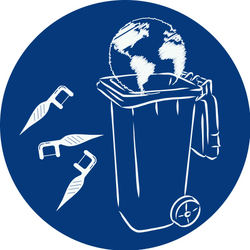
Don’t Miss This
This is only Part 1 of our scientific investigation into single-use flossers.
Check this out:
- Part 1 (Trash & Waste): You Are Here
- Part 2 (Climate Change): Single-Use Floss Picks Worsen Global Warming
- Part 3 (Greenwashing): Here’s How Single-Use Floss Picks Are Greenwashed
Introduction
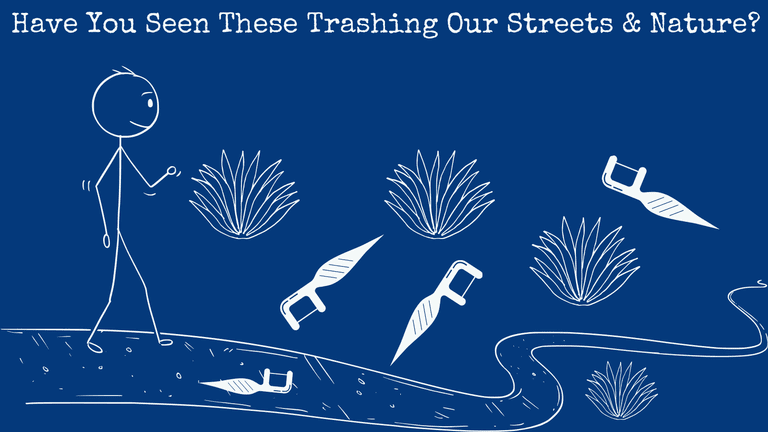
One thing is 100% certain:
Single-use floss picks pollute the planet.
Not just the plastic ones, either.
Even the “eco-friendly” single-use flossers add stress to the environment. That’s because they, by their very design, also require an endless supply of resources to produce over and over again.
And dentists make it clear: you shouldn’t reuse disposable flossers in an attemp to be eco-friendly. It’s unhealthy.
So just how much trash do single-use flossers create, then?
Can we quantify it?
Well, we did.
To make sure we weren’t blowing things out of proportion:
- A former EPA scientist double-checked our work.
- We cross-checked our numbers using completely different data. Our cross-check was in line with our initial calculations.
- Our conclusions are probably underestimations of the true environmental toll disposable floss picks have on the planet. We outline 12 reasons for why that’s the case.
- Six different mathematical models basically came to the same conclusions.
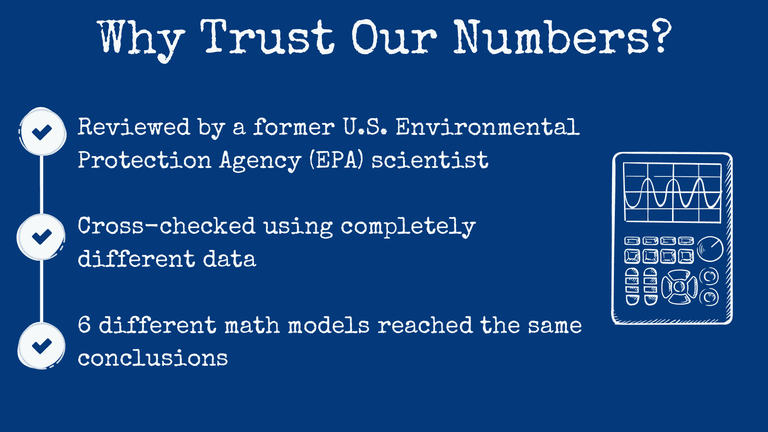
Oh, and there’s nothing to hide here.
Like any good scientist…
We reveal our rationale and calculations below for everyone to…
Analyze.
Discuss.
Replicate.
Our ultimate aim is also clear:
To get as many people to switch to an eco-friendly floss holder like the Element.
Results
Click or tap on the spreadsheet to enlarge it.
This spreadsheet basically sums up our calculations. For more granular insights on where all the numbers came from, keep reading.
Share the infographic below to help spread the word about these incredible results.
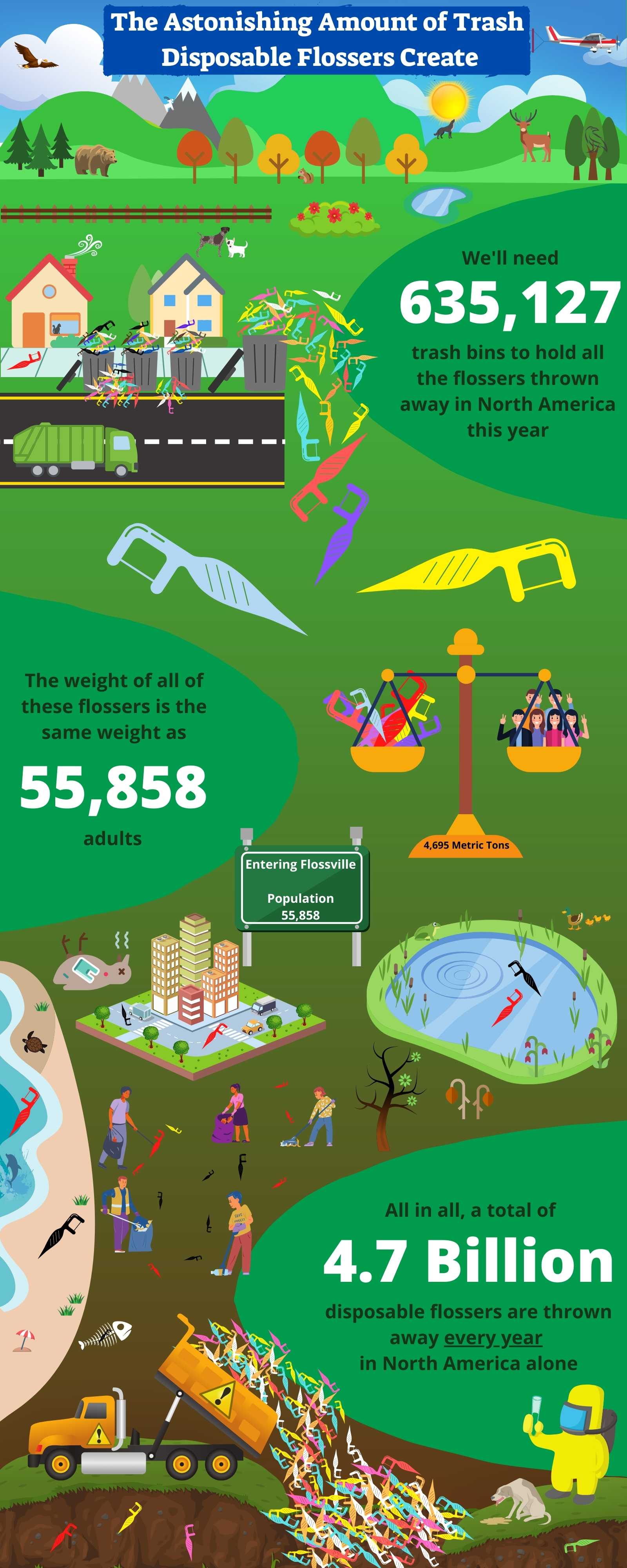
Methods
Disposable Flosser Price
We went to two different famous chain stores in the U.S.
There, we found a total of 19 different packages of floss between the two stores.
Next, we cleared all of our browser data. Then we created a new browser fingerprint. And finally we connected to a U.S. server on ProtonVPN.
This was done to minimize the impact of profiling on search results.
Then we went on Amazon.com…
Typed in “disposable flossers” without quotes…
And marked down the prices of the first 21 packages of flossers that came up in the search results. So long as they weren’t the same ones that we saw at the retail stores, that is.
Using these 40 packages:
We calculated the average retail cost among them.
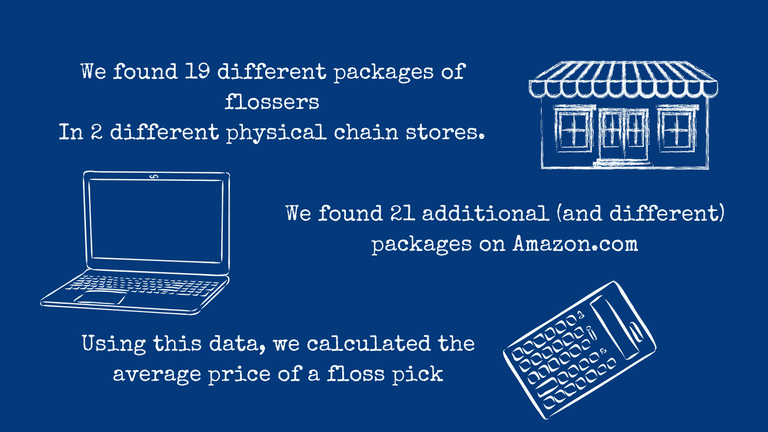
Just to be clear:
This was the pre-tax, undiscounted, no shipping fee cost.
After all, we can’t account for the infinite number of tax situations, temporary discounts, and shipping fee combinations.
Since each package contained a different amount of flossers, we calculated all of our numbers per 100 flossers.
Prices ranged from:
$0.97 to $26.00 per 100 disposable floss picks.
The low end was typically composed of bulk purchases of generic plastic flossers.
The high end tended to be single-use floss picks designed with gum care in mind. Or they were labeled as eco-friendly, vegan, and BPA-free single-use flossers.
The average retail (pre-tax) cost of 100 single-use flossers came out to be:
$5.15…
The median (middle) cost was:
$4.35…
Indicating a skew caused by the higher-priced ones.
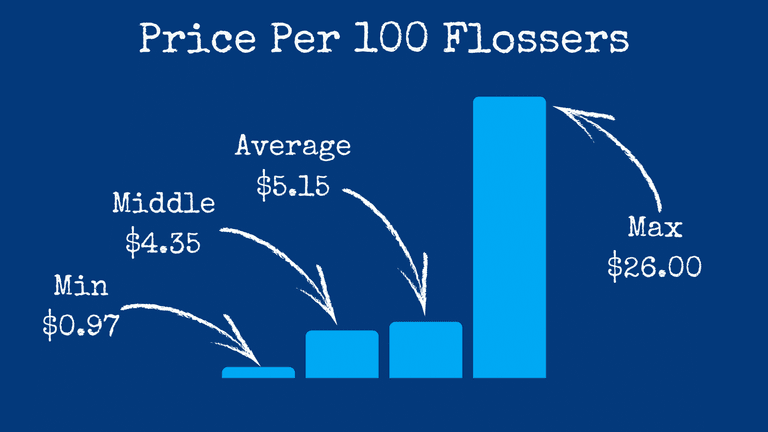
Therefore:
We used the median price in our calculations as we assumed that most people don’t buy the super expensive disposable floss picks.
Moreover:
If we excluded the two most/least expensive outliers, then the average price would be much closer to the median mentioned before. The same would happen if we remove all data points greater/lesser than one standard deviation away from the mean.
Disposable Flosser Weight
Using a digital scale we tared, we weighed a wide variety of single-use floss picks in their retail packaging. After all, the retail packaging is part of the trash weight.
The average trash weight per 100 disposable flossers, including retail packaging, was:
116.67 grams.
However, we decided to be conservative and round down to:
100 grams (3.53 oz).
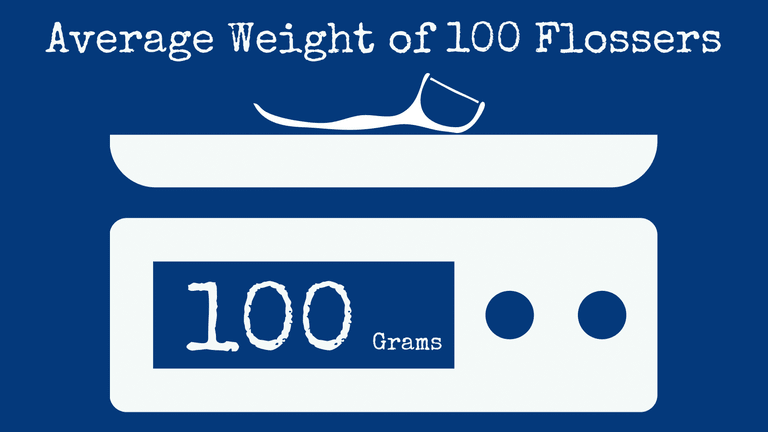
Some readers may not like our conservative strategy.
In the end, this choice minimizes the impact disposable floss picks have on the environment.
But we think that many readers will appreciate our hesitancy to potentially blow things out of proportion.
Disposable Flosser Volume
Do you neatly stack all of your trash in your bags and bins such that there’s no empty space between the items in the trash?
Probably not.
That empty space is, therefore, part and parcel of the volume of space that your trash takes up.
Furthermore:
You’ve probably noticed that single-use flossers most often come in a bag.
Sometimes they’re neatly arranged therein.
In that case, the bag appears slim.
Other times the flossers are all over the place.
That makes the bag look really bulky.
Once again, we believe that the reality is that most people don’t neatly stack their flossers in the trash bin. Accounting for the empty space these flossers naturally create around them reflects this reality.
So we randomly tossed flossers into their retail packaging and calculated out the volume of space they took up.
Per 100 flossers, this came out to be:
819.35 cm3 (50 in3).
That seems like a lot.
But we can put that into better perspective.
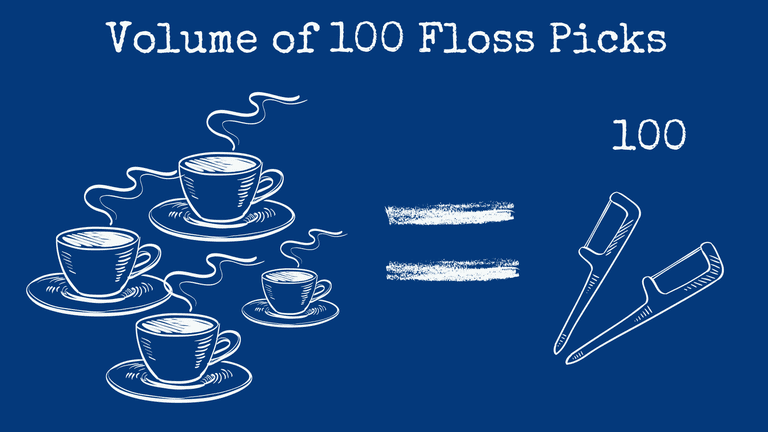
This is about the same volume as 3.5 cups, where 1 cup holds 8 oz.
Do you think that 100 of those single-use flossers can fit into 3.5 coffee mugs?
Doesn’t sound unreasonable now, does it?
Average Adult Weight
According to the U.S. Centers for Disease Control and Prevention (CDC):
The average measured weight of an American adult aged 20 and over is approximately:
185.3 lbs (84.05 kg). 1
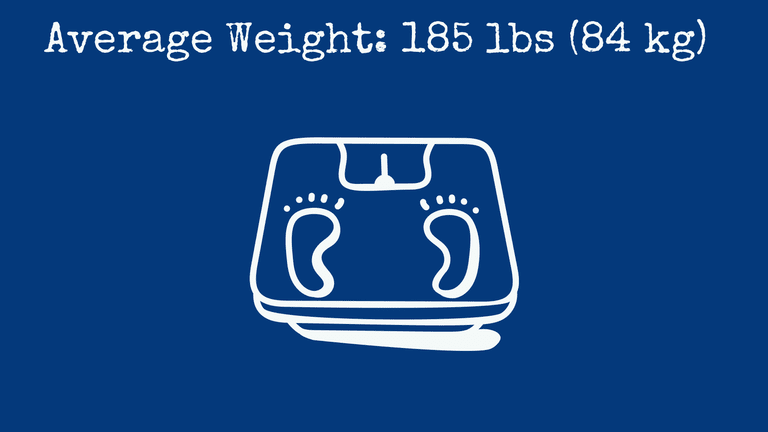
For ease of calculation, we assumed this population is roughly half male and half female and that the data for 18/19 year olds isn’t terribly different.
Waste Bin Volume
Single-use floss picks are often not recyclable.
But a lot of people are intuitively familiar with the size of a recycling bin.
So we decided to use the size of recycling bins as a way to put the volume of trash flossers create into better perspective.
The typical curbside recycling bin volume in the U.S. is about:
14 to 18 gallons, depending on the source. 2,3
We averaged it to 16 gallons (60.57 liters).
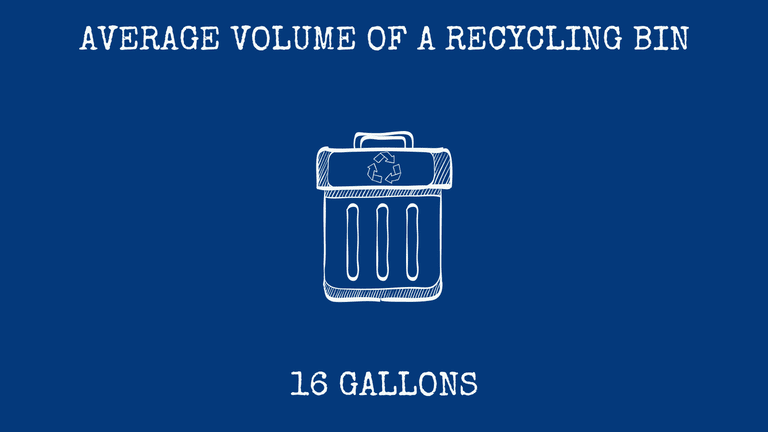
Disposable Flosser Market Value
Allied Market Research (AMR) apparently researched the revenue generated by disposable floss picks. 4,5
- Side note: it appears that AMR’s data shouldn’t be automatically trusted in full. 6 We accounted for this potential data hazard by using estimated ranges instead of point estimates. Then we cross-checked our numbers precisely because of this as well. Both of these strategies are described below. Nevertheless, these are currently the best publicly available estimates we have to work with.
Using the information from AMR…
And after clarifying their numbers via a chat with them…
We estimated the following:
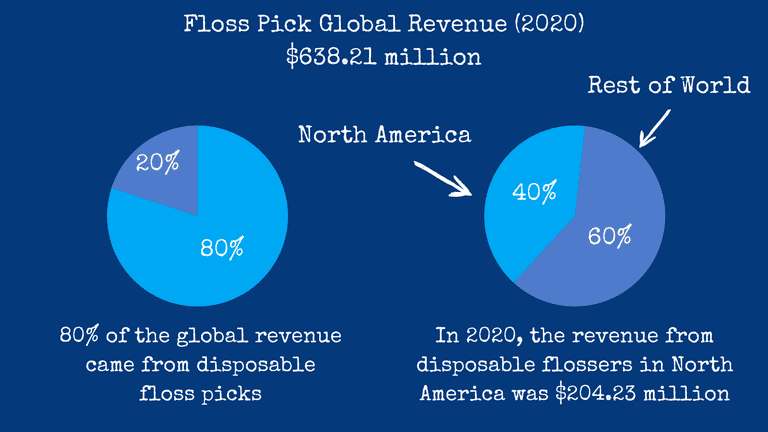
The global revenue from floss picks in 2020 was about:
$638.21 million.
Two-fifths of this revenue came from North America:
- U.S.
- Canada
- Mexico
Four-fifths came from single-use flossers, as opposed to reusable ones.
In other words:
The revenue from disposable flossers in North America was roughly:
$204.23 million in 2020.
Ranges, Not Point Estimates
The data we had to work with was limited.
Consequently:
We didn’t think it would be wise to provide a point estimate (a single number) for our conclusions.
Instead:
We assumed that the true environmental impact of single-use floss picks was upwards of 50% lower/higher than our calculated average.
Why 50%?
It was an arbitrary decision.
But we felt it was generous enough to account for known unknowns.
Here’s an example of how that works.
We calculated that the total weight of the trash created by single-use flossers in North America in 2020 was:
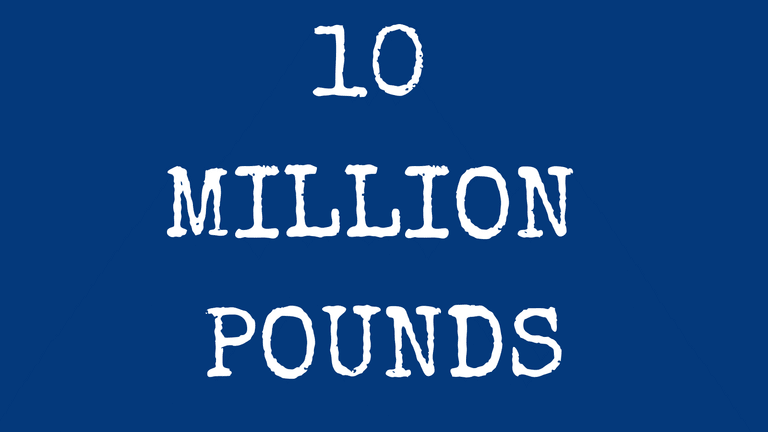
4695 metric tons (~10.3 million pounds).
That’s the point estimate.
The 50% higher/lower range is therefore 2347 – 7042 metric tons, the range wherein we believe the true number lies.
Crunching the Final Numbers
You now have all the information that you need to see how we performed our calculations.
Here’s the nitty-gritty for those who are interested:
1. We extrapolated AMR’s data from 2019, and its estimates out to 2026, in a linear fashion to arrive at a yearly growth of $31.91 million. Therefore, the global floss pick market size was estimated to be $638.21 million in 2020.
2. According to AMR, North America accounts for 2/5 of global revenue and disposable flossers account for 4/5 of global revenue. Using this information we estimate that revenues from the sale of single-use floss picks in North America were about $204.23 million in 2020.
3. The median cost of 100 disposable floss picks in the U.S. is $4.35 and the average trash weight is 100 grams. Using this and the value in #2, we could calculate that North America produced 4695 metric tons of disposable flosser trash in 2020. The 50% range is 2347 – 7042 metric tons.
4. The average U.S. adult’s weight stands at 84.05 kg. Using this and the info in #3, we could calculate our equivalent human weight for 2020. That year in North America, single-use floss picks created the same amount of trash as the weight of 55,858 U.S. adults. The 50% range is 27,929 – 83,787 U.S. adults.
5. The volume of trash, including retail packaging, created by 100 single-use flossers was estimated at 819.35 cm3. The average recycling bin’s volume is 16 gallons. Using this data, we found that we’d need 635,127 recycling bins to accommodate all of the single-use floss picks sold in North America in 2020. The 50% range is 317,564 – 952,691 recycling bins.
Cross-Check
Click the image to expand our data.
We didn’t think that putting all of our faith in AMR’s data was good enough.
So we performed a cross-check with very different types of data.
To that end:
We found that the population of the U.S. currently stands at about:
331,449,281.
Of this amount, 257,536,091 are adults. 7
Based on two studies:
36% of American adults floss every day. 8,9
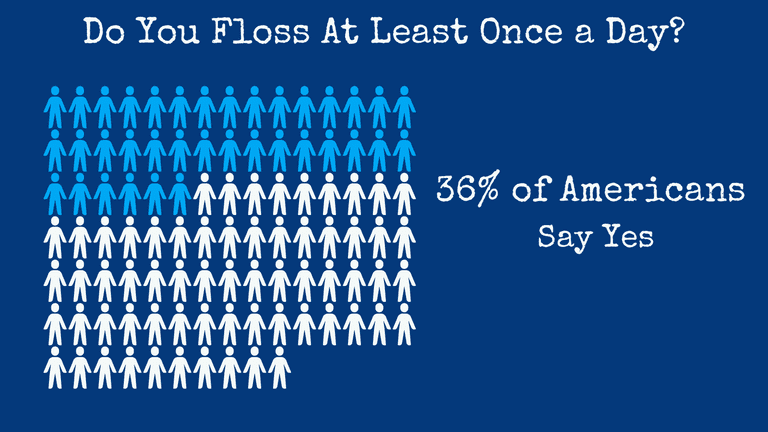
We then had to figure out how many of these Americans use disposable floss picks as opposed to other methods, like a reusable flosser or just floss.
We couldn’t find any good info on this.
To be very conservative we said:
Only 10% of Americans who floss at least once a day typically do so with a disposable flosser.
Our experience tells us this is an underestimation but we can’t prove it with hard data.
Yet if we look solely at the amount and wide variety of single-use floss picks in major retail stores, compared to that of packs of regular floss, 10% seems awfully low. It appears that a huge proportion of people are being catered to with all those choices.
With all of that in mind, we had enough info to crunch the numbers.
Recall that our estimated range from before was:
2347 – 7042 metric tons of trash for all of North America.
Our cross-check shows that the U.S. produces:
3415 metric tons of disposable flosser trash every year. This falls squarely into our estimated range.
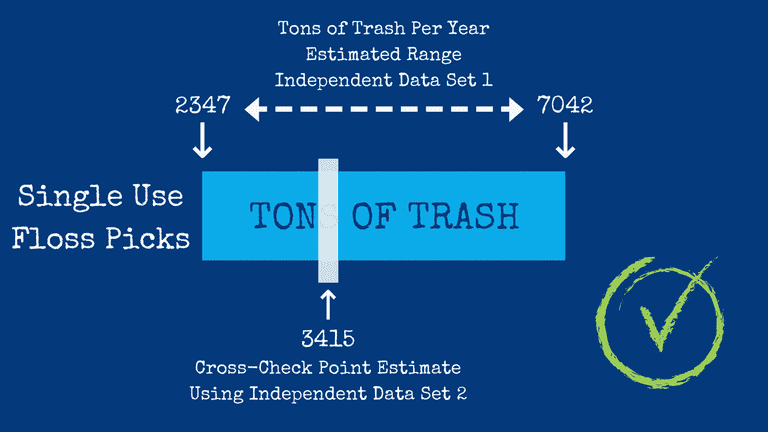
Logically, the cross-check value would rise had we included Canada and Mexico in our calculations.
While 3415 metric tons of disposable flosser trash every year seems high…it’s because it is.
It’s a very large amount of trash indeed.
Of course, some people may think that this number is so high that it’s probably wrong.
But if we put things into context:
Then 3415 metric tons is tiny compared to the total trash the U.S. produces on a yearly basis.
In terms of only municipal solid waste, the U.S. produces:
265 million metric tons of trash every year. 10
This means ~0.001% of all the municipal trash in the U.S. is caused by single-use floss picks.
In other words:
In every 100,000 pounds of garbage there’s 1 pound of disposable floss picks.
This isn’t to minimize the waste single-use flossers create.
Remember:
We estimate that around 2.3 – 7 billion flossers are dumped in North America.
About 3.4 billion single-use flossers are trashed in the U.S. alone.
So…
Ultimately…
Are floss picks bad for the environment?
Yes.
Our research makes it abundantly clear.
Now we finally know just how bad they are.
Limitations
12 Ways We May Have Underestimated the Ecological Impact
The data we worked with was imperfect.
So we tried to be conservative as much as possible.
As a result:
We may have underestimated the true environmental cost of disposable flossers by an unknown amount.
Here’s why our conclusions might be too low:
- Most importantly, our calculations speak to only 3 of the world’s countries (U.S., Canada, and Mexico). If we add the trash single-use flossers create in the rest of the world, things might look far worse than this article suggests.
- We didn’t include single-use floss picks that come in plastic boxes, which weigh more than retail plastic bags. Had we included them, the average and total trash weight would be higher.
- We didn’t include the packaging trash created by shipping these flossers to countries, stores, or homes.
- We used the weight of the average American adult in our calculations. The global average weight of an adult is almost certainly much lower. 11 This means that the number of average adults it takes to equal the yearly trash weight disposable floss picks create is far higher.
- We assumed that the disposable flosser market size is exactly 80% when AMR said it’s more than that. Using 80% as our data point likely underestimates the amount of trash created by single-use floss picks.
- We used a conservative trash (flosser + packaging) weight per 100 flossers. In fact, we rounded down by 14%. So this may underestimate the total trash weight of disposable floss picks as a result.
- We didn’t account for the many bulk disposable flosser purchases medical entities may make. Such purchases would drive the average/median price of single-use floss picks downwards. In turn, this means that more flossers would have to be sold in order to equal AMR’s revenue data. By extension, this means we might have underestimated the total weight and volume of trash.
- Our price per 100 disposable flossers reflects the median sticker price, not the median purchase price. In other words, the higher-priced flossers might be for sale but more people might reach for the cheaper ones. This means more flossers would have to be sold in order to equal AMR’s revenue data. By extension, this means we might have underestimated the total weight and volume of trash.
- For our cross-check, we didn’t include the impact of children flossing. Their impact would naturally add to the trash volume and weight.
- For our cross-check, we didn’t include the impact of occasional flossers, those who floss a few times per week. Again, their impact would only add to the trash volume and weight.
- For our cross-check, we assumed that all people who floss at least once a day floss only once a day. We know this isn’t true as some people floss multiple times a day in order to get rid of the food stuck between their teeth after every meal. However, we didn’t know what fraction of people do this. Had they been included, their impact would only drive our conclusions higher.
- For our cross-check, we assumed that only 10% of people who floss once a day do so with a disposable floss pick. This percentage may be a gross underestimation. If so, this minimizes the weight and volume of trash of single-use flossers Americans produce.
Ways We May Have Overestimated the Ecological Impact
Due to a lack of good data we may have overestimated the true environmental cost of single-use floss picks by an unknown amount. Here’s why:
- Assume that everyone neatly stacks or fully crushes their single-use floss picks in the garbage/recycling bin. This will cut back on the empty space around the flossers. If that’s true, then the volume of trash created would be considerably smaller. The weight would stay the same, however.
- Due to industrial compacting, the volume of space these flossers take up in a landfill may be relatively lower as compared to a personal waste bin.
The Known Unknowns
Due to a lack of good data, we’re unsure of how some factors may influence the true environmental cost of disposable floss picks:
- In our cross-check, we’re not certain how well Mexico’s and Canada’s flossing and disposable flosser data mimics America’s. These countries may add only a little bit to our estimates, or a lot.
- We don’t know how well North America’s results can be extrapolated to the rest of the world.
- We can’t be certain of how well AMR conducted their research and what limitations it has of its own. This is why we used estimated ranges and cross-checked our conclusions instead of relying on one source of information.
- In the research we cited, it’s theoretically possible that people lied about how often they floss. If that’s true, we don’t know by what amount.
Reviewer Commentary – 5 Alternative Models
Dr. Tashie brought up numerous alternative models that can be used to estimate the environmental impact of single-use floss picks using the data sourced herein.
For brevity’s sake, this article presented only our model.
Other models can rely on slightly different calculations. For example, you could use the mean vs. median, 95% confidence intervals vs. “Bayesian” uncertainty estimates, use or avoid outliers, rely on only one of the two flossing studies, and so on.
The point being: there is no one correct way to estimate the conclusions in these articles.
You might be curious as to what Dr. Tashie’s five alternative models, in between them, predicted. In summary, in the United States alone, between 2.89 – 5.26 billion disposable flossers are thrown away every year.
One Last Note
Last.
But not least.
We want to emphasize that we are not entirely opposed to single-use floss picks.
Shocking?
Well, there are probably legitimate cases where these are the only (best) choice of flossing for people. For example, individuals with mobility-related concerns may not like floss or floss handles. So single-use floss picks can help them maintain good oral hygiene.
The point of this investigation isn’t to discourage everyone from using disposable flossers. It’s to encourage as many people as possible to look to reusable alternatives if they’re a viable option for them.
3 Key Takeaways
Single-use floss picks are bad for the environment. Our original research proves it with hard data.
Here are the 3 key takeaways from our investigation:
- A total of 4.7 billion single-use flossers are thrown away every year in North America.
- The U.S. accounts for 73% of this amount.
- The entire weight of all of these single-use floss picks is 4,700 metric tons.
- That’s equal to the weight of an entire city’s adult population (56,000 adults).
- We’d need 635,000 (16-gallon) trash bins to hold all of these disposable floss picks.
In the end, just say “No!” to disposable floss picks.


